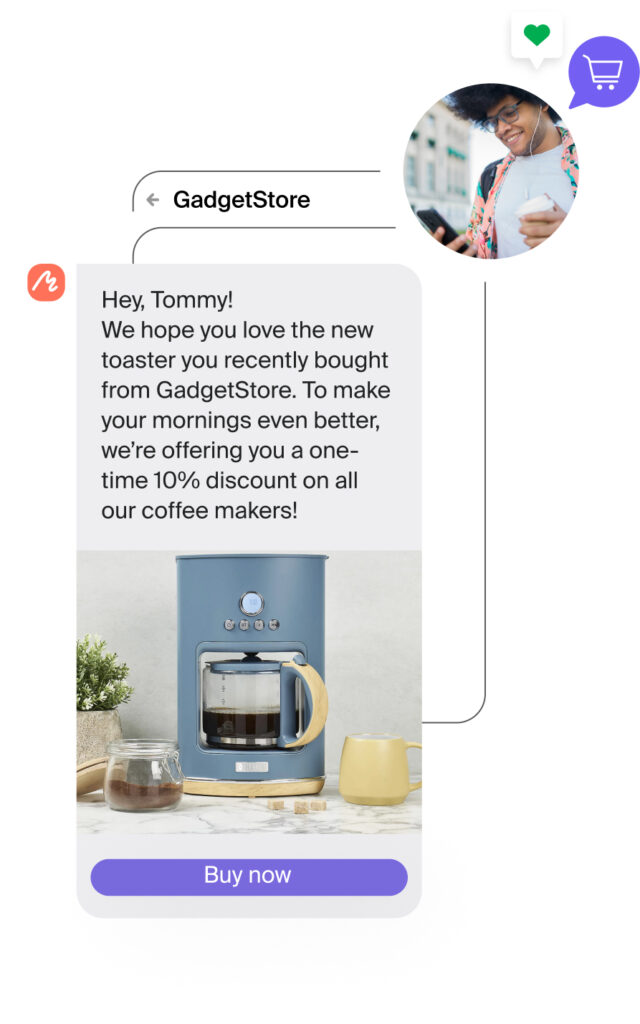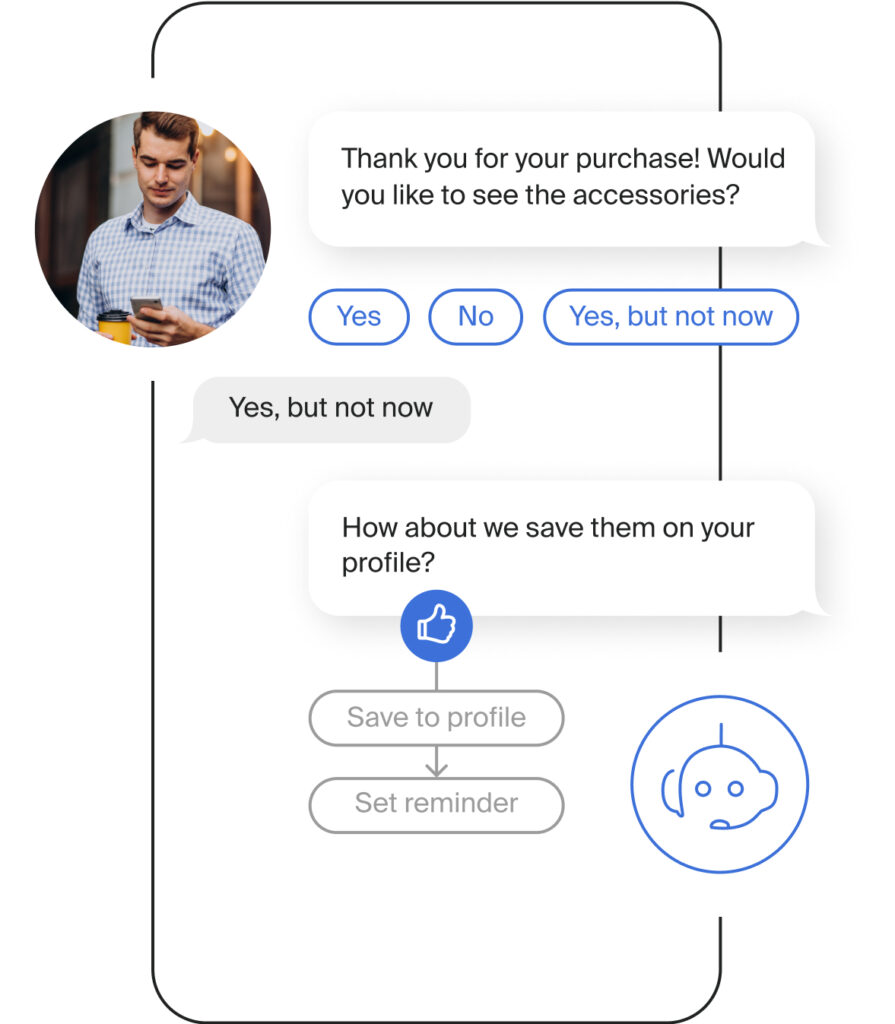Consumers’ predilection for switching devices and omnichannel shopping means the traditional, linear customer journey has long gone. Customers are taking the lead in how and when they interact with your business from initial awareness to the first sales conversion and beyond. A recent Salesforce survey shows that 74% use multiple channels to start and complete a transaction, while 66% use multiple devices. The best way to regain control and improve conversions is to utilise the most popular conversational commerce applications, integrate them with your top performing channels, analyse the data, and optimise every touchpoint. Research shows that 95.6% of online consumers access messaging apps regularly and 71% want personalised messages. Smart businesses are therefore focusing on conversational commerce with solutions like Viber Business Messages, WhatsApp Business Messages, SMS and AI Chatbots.

Why Optimise Touchpoints?
Every touchpoint influences a consumer’s perception of your business, staff, products and services. There are four types of touchpoints. Direct touchpoints are created and controlled by your business, like your website, bricks and mortar store, advertising, mobile messaging, and email marketing. Intrinsic touchpoints are inherent to your offering and happen when your customer interacts with your product. Indirect touchpoints occur outside of your control such as word of mouth, word of mouse, and viral posts. Customer-initiated touchpoints develop when consumers leave independent reviews, or talk about your brand on social media.
Research is divided on the number of touchpoints it takes to convert to a sale. Popular opinion amongst marketers is that it takes around 8 touchpoints, but research by Google shows it can take between 20 and 500, depending on the product! So, it’s clear we need to streamline the customer journey and make every touchpoint count.
Nike are masters of touchpoint optimisation. At the pre-sales stage, prospects and repurchasing customers can enjoy the hyper-personalisation provided by Nike’s 3D trainer customisation platform. Nike’s presence in Roblox in the Metaverse in the form of a “NikeLand” virtual store is reaching a whole new target market sector for the brand. In their real-life stores, the NikePlus membership initiative encourages loyalty in the post-purchase stage of the customer journey. They use a mix of SMS, Viber, WhatsApp and Chatbots to promote these campaigns globally.

Pre-sale Touchpoints
Getting the Prospect to Opt-in
To protect consumers from spam, both WhatsApp and Viber only allow customers to be contacted via the application if they’ve given express consent.
Fortunately, there are several ways to get your business messaging account on your prospects’ radar. A well-placed Viber or WhatsApp icon on your Contact, Home, Blog and Product pages is a great start. If you have a bricks and mortar store you need to integrate your offline and online strategies, so consider using the Viber QR code generator and adding the code to store signage, flyers, and your website. Use a clear call to action (CTA) along the lines of “Sign up for Viber updates and never miss a sale or new product line again”. Prospects are automatically subscribed as soon as they click the link. Businesses are searchable on Viber so, if a prospect contacts you via your Viber business account they’re deemed to be opted-in. Once prospects are opted in you can start using Viber Business Messages to solidify the relationship and move them towards sales conversion.
Personalised Advertising
Viber ads can be created to pop-up after a call with a consumer, in the Viber Explore area, or they can appear as banner ads in a prospects’ chat and call screens, or inbox. Targeting options like location, age, gender and interests enable you to create personalised ads. Viber has 1B+ Android downloads and a 25% click through rate for the Buy Now CTA button on product ads!
Connecting the Journey
Click-to-WhatsApp ads are CTA buttons incorporated into targeted video, single image or carousel Facebook and Instagram ads. When they click, prospects are redirected to a WhatsApp chat where they can learn more about your products and services and chat directly with a live rep. You could also direct them to your AI chatbot, which can ask them about their needs, showcase relevant products and answer their pre-sale questions, freeing up your live reps for more complex queries.
Using a similar strategy, Indian eCommerce company Flipkart sent prospects to their WhatsApp chatbot, which used emojis and puzzles to showcase products, resulting in 3.5 times more conversions, 7 times more quality visitors, and $2.5 million USD in revenue in just two weeks!

Mid-sale Touchpoints
Two critical points in achieving and optimising mid-sale conversions are cart abandonment and the opportunity for upselling and cross-selling. Nearly 70% of consumers abandon their carts and, if you don’t win them back fast, you could lose them forever. Upselling and cross-selling are great ways to provide personalisation while increasing your Average Order Value (AOV) and Customer Lifetime Value (CLV).
Integrating the Touchpoints
With Viber Transactional Messages you can initially send a simple abandoned cart reminder. Alternatively you can use a more dynamic Promotional Message with a photo of the item they‘ve left behind, or a carousel of similar product images. The average CTR for Viber messages is 82%, so a lot of users are likely to click, return and go through to the next touchpoint.
If the reminder isn’t enough then, after a short interval, send a message including a discount code. Or even better, integrate with other potential touchpoints in the sales journey by offering triple points if they retrieve their basket and join your loyalty scheme. Optimal interval times between your business messages will depend on your specific sector, business and client profiles so be sure to experiment and analyse you Viber analytics.
If your customer’s app of choice is WhatsApp, you can send a WhatsApp message to reverse an abandoned shopping cart. In addition to a personalised offer just for them, you can add a “Pay Now” CTA button in the body of the text, greatly reducing the number of touchpoints to the final sales conversion.
Optimising with Failed Sale Feedback
WhatsApp customers are 33% more likely to finish a purchase than the average consumer. However, if it appears that the customer is not coming back for this particular abandoned cart, send a message asking them to answer a short feedback survey. This way you can discover whether they found it cheaper or bought a higher value, top-of-the-range item elsewhere. This is all vital data to help you create the right price points, curate the most sought-after product lines and optimise your touchpoints to boost sales going forward.
Post-sale Touchpoints
When people talk about post-sale touchpoints they generally refer to transactional messages for shipping, delivery, returns and refunds. Many business leaders are concerned that they can’t influence the intrinsic touchpoints that occur when their product has been delivered to the customer. Conversational commerce applications allow you to take control of even these more remote touchpoints.

Managing Intrinsic Touchpoints
Imagine your new customer has purchased a new home office desk that needs to be built. Prior to delivery, you can send them a Viber or WhatsApp message with an instruction video and a link to download a full manual. Similarly, you could send them an SMS, WhatsApp or Viber message asking them if they have everything they need and telling them your chatbot is on hand to answer any questions and show them a “how to” video, with a link to the bot. This way the customer knows help is at hand and can decide if and when they need it. This has the added benefit of taking the customer back to your website where they may see other products they like. It also gives your chatbot the opportunity to cross-sell some other home office accessories such as a chair, ergonomic arm and wrist rests, a mouse and keyboard, or some stationery. This can be a very lucrative touchpoint optimisation opportunity as Invespo research shows that 7% of e-commerce store visitors are on the site as a result of cross-selling and their purchases can account for more than 26% of overall revenue!
A few days after the product has been delivered, send a timely message to the customer to ask if they are enjoying their item and invite them to leave their feedback via a Viber or WhatsApp survey or by linking directly to your chatbot. This enables customers to have their say in a controlled environment where you can collect and analyse the data. In the short term you can offer them immediate product support or some sort of compensation if they are not happy. In the long term you can use the information to improve your products, streamline the customer journey, optimise your touchpoints and, with permission, put good reviews on your website to help convert other new leads to customers.
Given the stats we looked at in the opening paragraph, it’s concerning that 30.9% of retailers can’t track consumers across devices and another 38.2% can only track some consumers, some of the time. To combat this, maximise your touchpoint optimisation and stand out from the competition with relevant messages delivered at the right time through the right channel. GMS Business Communications Suite integrates all your conversational commerce applications, giving you a 360-degree insight into your messaging and chatbot campaigns to help you integrate and optimise your touchpoints, as well as to continuously improve your overall customer experience.

